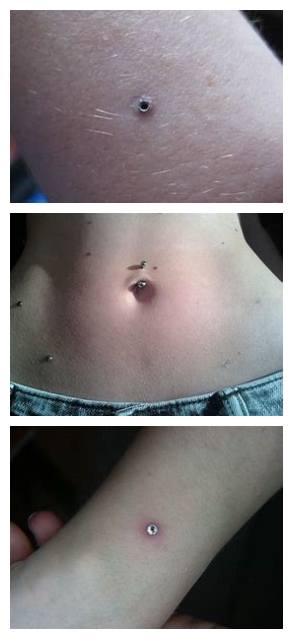Body piercing is a practice that is performed for many different reasons which include traditional, religious, aesthetic, self expression, and even for pleasure. In recent years an increasing trend in body piercing has been that of dermal piercing also known as microdermal piercing. It consists in the cutting of the dermis layer of the skin and the introduction of body jewelry. It can be performed in any part of the body.
The dangers related to dermal piercing

Body piercing is quite an invasive procedure and on occasion can result in a number of complications of which some are considered below:
- Allergy – most often titanium or nobium is used as material as they are common hypoallergenic. At occasions when non-hypoallergenic jewelry is used it can cause allergy.
- Infection – there is the risk of infection from dermal piercing. Infection can be of viral, fungal, or bacterial origin. Microorganisms mostly known as a wide source of infection in dermal piercing include the staphylococcus aureus, the pseudomonas, and the streptococcal species. The use of infected needles and other equipment can also be the cause in the transmission of hepatitis B and C
- Rejection – the risk of rejection from the body can also occur. It such circumstance, the body recognizes a foreign body and rejects it. Extreme pain, discharge, and prolonged inflammatory reaction are signs of rejection.
- Pain – dermal piercing can result in extreme pain particularly when the perforation causes an inflammatory response.
Procedure for dermal piercing removal
As noted there are many dangers that can result due to dermal piercing. If you are having complications with your dermal piercing which requires having it removed, there are certain things that need to be taken into consideration. Dermal implants are often permanently placed on the body surface and often do not have any exit hole but often bonds to the implanted anchor and locks in place.it therefore often is easy to remove the exposed jewelry but requires the assistance of a professional to remove the anchor. Trying to tear or pierce forcefully can result in extreme pain, scarring, and in infection.
If you unscrew the top of the threaded end you must take note that leaving it without replacing jewelry can result in having the skin close up around the piercing. To remove the anchor, your piercer or a professional will make an incision in your skin using a scalpel in order to remove the anchor.
Treatment of the site of the dermal piercing removal
After the anchor has been removed the site where the dermal piercing must be washed properly with antibacterial soap and water; the treatment should continue daily until the incision is completely healed. It must be noted that the location of the dermal piercing after removal can leave scarring which in the majority of cases can be a small spot or dot. Dermal piercing is an increasing trend that is becoming a statement of fashion for many people. Having knowledge of how to remove and how to avoid infection is necessary.

